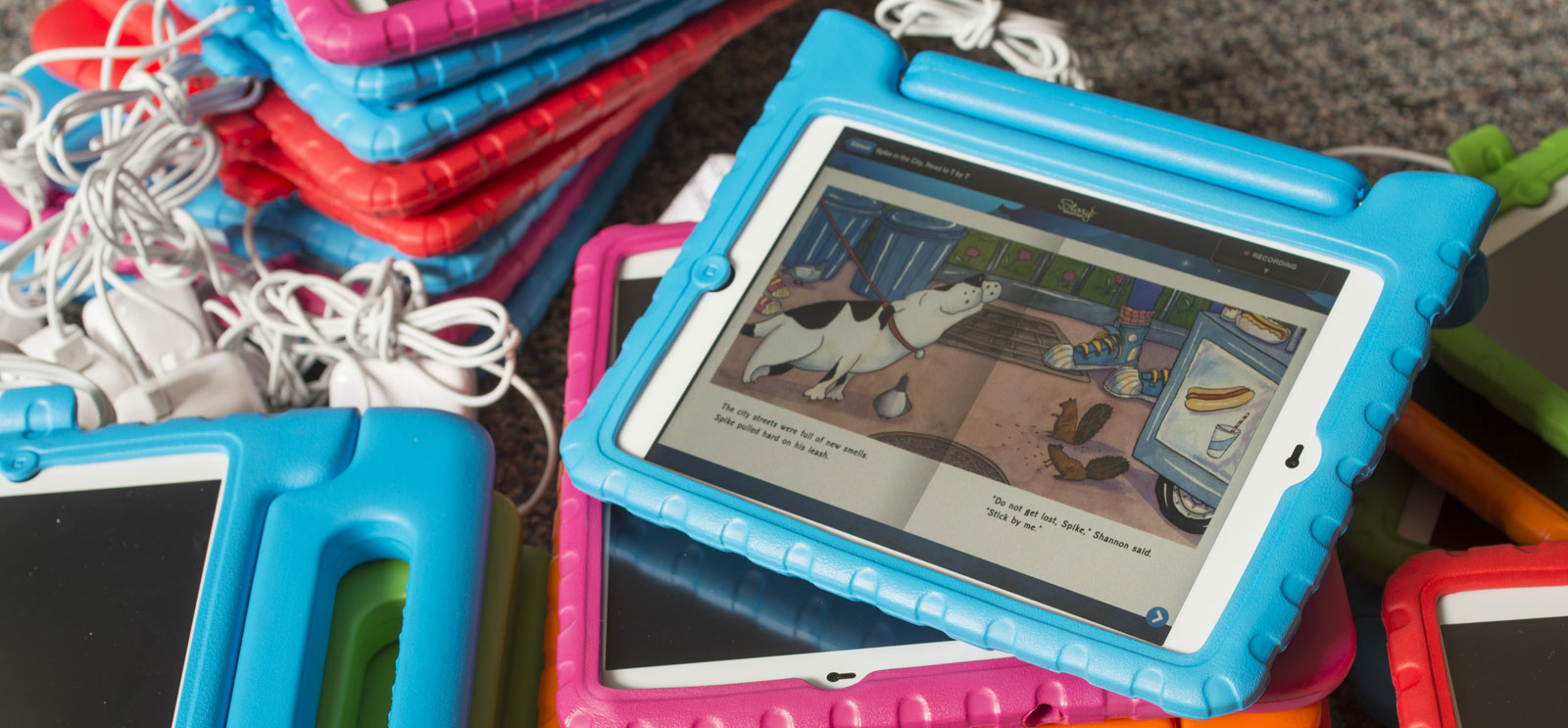
Families in the PACT program receive a tablet loaded with 500 digital storybooks. (Photography by Robert Kozloff)
Researcher Ariel Kalil finds “light-touch, low-cost” parenting tools.
Read to your kids. Talk to them. Be present. This advice is nothing new, but great disparities exist among households. A groundbreaking 1995 study by two researchers from the University of Kansas found that by age three, children from high-income families have heard roughly 30 million more words than those from low-income families, putting many kids at a disadvantage well before they hit kindergarten.
Since then, efforts to narrow the so-called word gap haven’t always achieved their goals. “The programs we’ve had historically have been very intensive, demanding a lot of parents’ time and energy,” says developmental psychologist Ariel Kalil, professor in the University of Chicago Harris School of Public Policy. Often geared toward low-income single mothers, a typical model runs for a year or more and relies on trained educators to do coaching in homes, guiding parents through activities that teach them to create a more developmentally stimulating environment.
“We really need a completely new approach in thinking about how to support families,” says Kalil, codirector of the University’s new Behavioral Insights and Parenting (BIP) Lab. The experimental research center focuses on high impact, cost-effective interventions that promote parent engagement in children’s development and target socioeconomic gaps in achievement
For her, that meant turning to behavioral economics, a field focused on understanding what drives people to make the decisions they do—and helping them make better ones. “Parenting is stressful, and for low-income parents in particular, life can be very stressful,” says Kalil, who studies the effects of income inequality on child development and also directs Chicago Harris’s Center for Human Potential and Public Policy. While most policy focuses on narrowing achievement gaps through the education system, her research and that of the center investigate how the family environment enhances or limits the opportunities young people have throughout their lives.
“There are lots of things that parents say they want to do for their kids and yet they don’t,” Kalil says. Behavioral economics, which draws on fields like psychology, neuroscience, and microeconomics, provides a road map to make good on those intentions. “There’s a whole tool kit that comes out of the field showing that you can move the needle on a set of behaviors using some very simple techniques,” she says. For example, telling someone that smoking causes cancer isn’t nearly as effective at helping them kick the habit as having them write down how many fewer cigarettes they pledge to smoke in the coming week. Other tools include having people publicly commit to a goal, providing feedback, and giving simple rewards for goals met.
These “light-touch, low-cost” approaches form the cornerstone of the BIP Lab, which Kalil leads with Chicago Harris professor and former dean Susan Mayer. The lab is collaborating on several projects with Chicago Booth’s Center for Decision Research, founded by pioneering behavioral economist Richard Thaler. Thaler’s 2008 book Nudge (Yale University Press) had a significant influence on Kalil. “Behavioral science has shown you can change really entrenched behaviors: get people to lose weight, smoke less, exercise more, save more,” Kalil says. “We looked at all of this literature and said, ‘Why isn’t anyone doing this for parents?’”
The lab’s inaugural study, Parents and Children Together (PACT), targets children’s school readiness, using behavioral insights to increase the amount of time parents read with their preschoolers. Families in the six-week experiment—all from Chicago Head Start programs—receive a tablet loaded with 500 digital storybooks and picture books in English and Spanish. Each time a parent reads a book aloud, an audio app records it, allowing researchers to track reading amounts.
Similar to traditional interventions, parents in the control group are reminded at the outset that reading is good. They go home, tablet in hand, with instructions to read with their kids for the next six weeks. The experimental group, however, “gets this whole suite of what we call behavioral nudges and incentives,” Kalil says. They pledge how much time they’re going to read in the next week, receive daily text reminders of those goals, and get weekly feedback on progress. Those who hit their goal, or read more than any other family, get a boost when their screen lights up with a digital image. Group text messages also recognize parents for meeting or exceeding goals.
The result? In the lab’s pilot study of 100 families, those receiving the nudges spent double the amount of time reading to their kids as the control group, a result that surpassed researchers’ expectations. “This is the kind of impact that programs costing orders of magnitude more money per family have achieved,” Kalil says. “It’s a treatment that is extremely cheap and highly scalable.”
To that end, the lab has partnered with Chicago Booth’s Polsky Center for Entrepreneurship and Innovation to quickly bring their intervention to a wide market, transforming it into a tool that programs can use to improve parenting and child outcomes.
“The gaps in child development open up very early in a child’s life, and they persist throughout childhood,” Kalil says. “Our fundamental mission is to improve that trajectory.”
